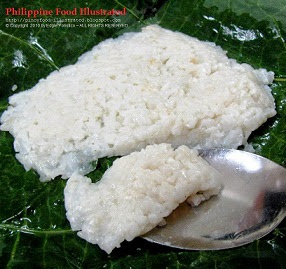| Pasong from a food stall in Cotabato City. |
pasong - /pá-song/ (Maguindanaon rice meal) [n.] conic rice. Steamed rice wrapped in banana leaf folded into a conic shape.
Plain ordinary rice is steamed into kanin. A ladle scoop of steamed rice is wrapped in banana leaf and folded into a conic shape. Before wrapping, the banana leaf wrapper can be made pliant by wilting. It is done by passing the leaf over the flame or hot ember.
This is how the Maguindanaos of Mindanao sold their cooked rice or packed them as baon (food brought along to work or travel).
The packaging is very environmentally friendly as it uses a banana leaf as a wrapper and not the non-biodegradable and health-hazard sheets of plastic cellophane or styrofoam. Not, unless you use a plastic bag to hold the pasong when buying it.
Related posts:
Pastil

Puso (sweetened rice)
puso (plain
All photos by Edgie Polistico are copyrighted. ALL RIGHTS RESERVED.
If you liked this post and our site, share it.
Let us know your opinion on the subject. Feel free to comment in the comment section, below. We need to know what you think.
Tell us what other topics you would like us to write, share, and discuss about.
For more about Filipino food, see this Philippine Food, Cooking, and Dining Dictionary. It is OPEN and FREE.
Continue to follow my blogs. You can also follow and learn more by joining us in our Facebook group. Have more bits and pieces about our kind of food, ingredients, and ways of cooking, dining, and knowing food culture across the 7,641 islands of the Philippines.
Encouragement and enthusiasm are not enough. I also need moral support, prayers, and anything else that can uplift my spirit and keep my good reasons. Keep them coming. All I know is that I am happy with what I am sharing and giving away. If you are pleased and happy with what I am doing, just smile and please share the happiness. Keep sharing and include to share the PHILIPPINE FOOD ILLUSTRATED. I feel energized when my blog becomes one of the reasons why you are happy and smiling.
Edgie Polistico
For more about Filipino food, see this Philippine Food, Cooking, and Dining Dictionary. It is OPEN and FREE.
Continue to follow my blogs. You can also follow and learn more by joining us in our Facebook group. Have more bits and pieces about our kind of food, ingredients, and ways of cooking, dining, and knowing food culture across the 7,641 islands of the Philippines.
Encouragement and enthusiasm are not enough. I also need moral support, prayers, and anything else that can uplift my spirit and keep my good reasons. Keep them coming. All I know is that I am happy with what I am sharing and giving away. If you are pleased and happy with what I am doing, just smile and please share the happiness. Keep sharing and include to share the PHILIPPINE FOOD ILLUSTRATED. I feel energized when my blog becomes one of the reasons why you are happy and smiling.
Edgie Polistico

.jpg)





%2B2.jpg)
.jpg)
.jpg)
.jpg)
.jpg)








